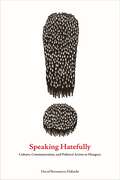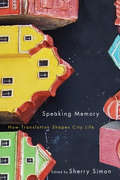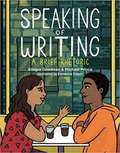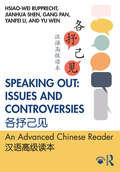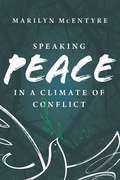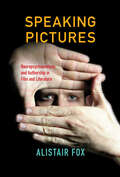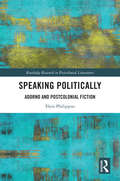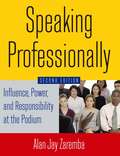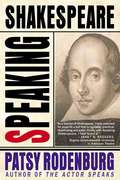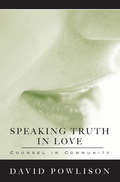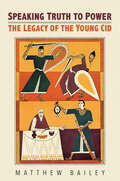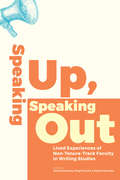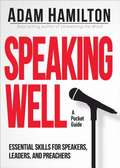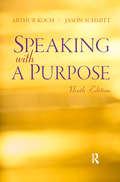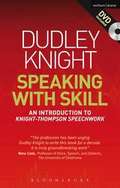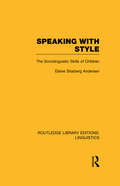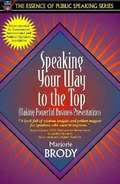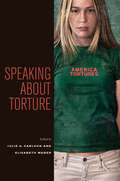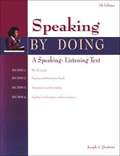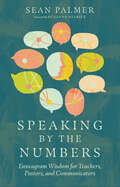- Table View
- List View
Speaking Hatefully: Culture, Communication, and Political Action in Hungary (Rhetoric and Democratic Deliberation)
by David Boromisza-HabashiIn Speaking Hatefully, David Boromisza-Habashi focuses on the use of the term “hate speech” as a window on the cultural logic of political and moral struggle in public deliberation. This empirical study of gyűlöletbeszéd, or "hate speech," in Hungary documents competing meanings of the term, the interpretive strategies used to generate those competing meanings, and the parallel moral systems that inspire political actors to question their opponents’ interpretations. In contrast to most existing treatments of the subject, Boromisza-Habashi’s argument does not rely on pre-existing definitions of "hate speech." Instead, he uses a combination of ethnographic and discourse analytic methods to map existing meanings and provide insight into the sociocultural life of those meanings in a troubled political environment.
Speaking Memory: How Translation Shapes City Life
by Sherry SimonSpeaking Memory evokes the complex "language-scapes" that form at the crossroads of culture and history in cities. While engaging with current debates on the nature and role of translation in globalized urban landscapes, the contributors offer a series of detailed and nuanced readings of "translational" cities - their histories, their construction and transformation in memory, and the artistic projects that tell their stories. The three sections of the book highlight historical case studies, conceptual issues, and text-based analyses of city scripts, in particular as they relate to creative literary practices and language interventions on the surface of the city itself. In this volume, translation points to the dissonance of city life, but also to the possibility of a generalized, public discourse - a space vital to urban citizenship, where the convergence of languages can be the source of new conversations. Essays cover a variety of topics and approaches, bringing new voices and insights to discussions on multilingualism and translation in the urban contexts of cities including Dublin, Montevideo, Montreal, Prague, and Vilnius. Defining cities as fields of translational forces where languages are both in conversation and in tension, translation in Speaking Memory is stretched beyond its usual confines, encompassing literary, artistic, and cultural practices that permeate everyday contemporary life. Contributors include Liamis Briedis (Vilnius University), Matteo Colombi (University of Leipzig), Michael Cronin (Dublin City University), Michael Darroch (Windsor University), Roch Duval (Université de Montréal), Andre Furlani (Concordia University), Simon Harel (Université de Montréal), William Marshall (Stirling University), Sarah Mekdjian (Université Paris III), Alexis Nouss (Université d'Aix en Provence), Katia Pizzi (University of London), Sherry Simon (Concordia University), Will Straw (McGill University), and Miriam Suchet (Université Paris III).
Speaking Memory: How Translation Shapes City Life (Culture of Cities Series #5)
by Sherry SimonSpeaking Memory evokes the complex "language-scapes" that form at the crossroads of culture and history in cities. While engaging with current debates on the nature and role of translation in globalized urban landscapes, the contributors offer a series of detailed and nuanced readings of “translational” cities – their histories, their construction and transformation in memory, and the artistic projects that tell their stories. The three sections of the book highlight historical case studies, conceptual issues, and text-based analyses of city scripts, in particular as they relate to creative literary practices and language interventions on the surface of the city itself. In this volume, translation points to the dissonance of city life, but also to the possibility of a generalized, public discourse – a space vital to urban citizenship, where the convergence of languages can be the source of new conversations. Essays cover a variety of topics and approaches, bringing new voices and insights to discussions on multilingualism and translation in the urban contexts of cities including Dublin, Montevideo, Montreal, Prague, and Vilnius. Defining cities as fields of translational forces where languages are both in conversation and in tension, translation in Speaking Memory is stretched beyond its usual confines, encompassing literary, artistic, and cultural practices that permeate everyday contemporary life. Contributors include Liamis Briedis (Vilnius University), Matteo Colombi (University of Leipzig), Michael Cronin (Dublin City University), Michael Darroch (Windsor University), Roch Duval (Université de Montréal), Andre Furlani (Concordia University), Simon Harel (Université de Montréal), William Marshall (Stirling University), Sarah Mekdjian (Université Paris III), Alexis Nouss (Université d’Aix en Provence), Katia Pizzi (University of London), Sherry Simon (Concordia University), Will Straw (McGill University), and Miriam Suchet (Université Paris III).
Speaking Of Writing: A Brief Rhetoric
by Allegra Goodman Michael Prince Emmeline PidgenCan a writing textbook inform and entertain? Can a very brief rhetoric also function as a stand-alone guide to college writing? Yes and yes. Speaking of Writing is a concise yet comprehensive rhetoric with readings. Informed by scholarship in Writing Studies, this book follows four college students from diverse backgrounds as they face the challenges of reading, writing, and critical thinking in first-year writing and across the disciplines. Each chapter engages students in relatable, often humorous scenarios that focus on key challenges. Through its story-based approach, Speaking of Writing enacts student-centered and process-based pedagogy, showing students learning to address fundamental questions: How can I apply my own strategies for success to new assignments? How can I maintain my own voice when asked to compose in an academic style? What do college professors mean by a “thesis,” and how is this different from what my high-school teachers meant? Why is this argument weak, and how can I make it stronger? The book’s narrative vividly dramatizes a draft-and-revision process that includes instructor feedback, peer review, and careful research.
Speaking Out and Silencing: Culture, Society and Politics in Italy in the 1970s
by A. BullCommonly referred to collectively as the anni di piombo -- years of lead -- the 1970s have been seen as a parenthesis in Italian history, which was dominated by political violence and terrorism. The seventeen essays in this wide-ranging collection adopt different scholarly perspectives to challenge this monolithic view and uncover the complexity of the decade, exploring its many facets and re-assessing political conflict. The volume brings to the fore the ruptures of the period through an examination of literature, film, gender relations, party politics and political participation, social structures and identities. This more balanced assessment of the period allows the vibrancy and dynamism of new social and cultural movements to emerge. The long-lasting effects of this period on Italian culture and society and its crucial legacy to the present are lucidly revealed, dispelling the widely-held belief that the 1970s were largely a regressive decade. With the contributions: Anna Cento Bull, Adalgisa Giorgio -- The 1970s through the Looking GlassPiero Ignazi -- Italy in the 1970s between Self-Expression and OrganicismPaola Di Cori -- Listening and Silencing. Italian Feminists in the 1970s: Between autocoscienza and TerrorismAmalia Signorelli -- Women in Italy in the 1970sLesley Caldwell -- Is the Political Personal? Fathers and Sons in Bertolucci's Tragedia di un uomo ridicolo and Amelio's Colpire al cuoreJennifer Burns -- A Leaden Silence? Writers' Responses to the anni di piomboAdalgisa Giorgio -- From Little Girls to Bad Girls: Women's Writing and Experimentalism in the 1970s and 1990sEnrico Palandri -- The Difficulty of a Historical Perspective on the 1970sMark Donovan -- The Radicals: An Ambiguous Contribution to Political InnovationCarl Levy -- Intellectual Unemployment and Political Radicalism in Italy, 1968-1982Roberto Bartali -- The Red Brigades and the Moro Kidnapping: Secrets and LiesTom Behan -- Allende, Berlinguer, Pinochet... and Dario FoPhilip Cooke -- 'A riconquistare la rossa primavera' The Neo-Resistance of the 1970sClaudia Bernardi -- Collective Memory and Childhood Narratives: Rewriting the 1970s in the 1990sValeria Pizzini Gambetta -- Becoming Visible: Did the Emancipation of Women Reach the Sicilian Mafia?Davide PerO -- The Left and the Construction of Immigrants in 1970s ItalyAnna Cento Bull -- From the Centrality of the Working Class to its Demise: The Case of Bagnoli, Naples
Speaking Out: An Advanced Chinese Reader 汉语高级读本
by Gang Pan Hsiao-wei Rupprecht Jianhua Shen Yanfei Li Yu WenSpeaking Out: Issues and Controversies 各抒己见 is an advanced Chinese language textbook that explores topics such as human nature, moral values, mass consumption, Western influences, and technological innovation. In presenting subjects that reflect major concerns in contemporary China, the book invites students to reflect upon the forces shaping modern Chinese society. This textbook presents ten lessons in five units entitled "Constancy and Change," "Joy and Sorrow," "Right and Wrong," "Chinese Tradition and Western Influence," and "New and Old." These pairs of opposites conjure up an ever-changing world of ebb and flow, a world that stimulates learners’ imaginations and arouses their enthusiasm for open dialogue and lively discussion. Concise in language and with lessons in both simplified and traditional characters, the textbook is a valuable aid for university students interested in passing the HSK Level VI or attaining ACTFL advanced-level proficiency. Accompanying audio recordings can be found online at www.routledge.com/9780367902704.
Speaking Peace in a Climate of Conflict
by Marilyn McEntyreWhat can we learn from contemporary writers about keeping public conversation compassionate, vigorous, faithful, and life-giving?Those who want to avoid simplistic partisan rhetoric and use words in a challenging, spirited way need practical strategies. This book offers a range of them. Drawing upon the work of exemplary contemporary writers, Speaking Peace in a Climate of Conflict shows how to speak and write clearly and generously. For example, we can attend more carefully to the effects of metaphors, recognize and avoid glib euphemisms, define terms in ways that retrieve core meanings and revitalize them, and enrich our sense of history by deft use of allusion. Contemporary readers are awash in many words that have been cheapened and profaned. But with deliberate use of intelligence and grace we can redeem their &“sacramentality&”—humanely uttered words can convey life-giving clarity and compassion. Speaking Peace in a Climate of Conflict is an homage to outstanding wordsmiths who have achieved that potential and an invitation to follow them in making well-chosen words instruments of peace.
Speaking Peace in a Climate of Conflict
by Marilyn McEntyreWhat can we learn from contemporary writers about keeping public conversation compassionate, vigorous, faithful, and life-giving?Those who want to avoid simplistic partisan rhetoric and use words in a challenging, spirited way need practical strategies. This book offers a range of them. Drawing upon the work of exemplary contemporary writers, Speaking Peace in a Climate of Conflict shows how to speak and write clearly and generously. For example, we can attend more carefully to the effects of metaphors, recognize and avoid glib euphemisms, define terms in ways that retrieve core meanings and revitalize them, and enrich our sense of history by deft use of allusion. Contemporary readers are awash in many words that have been cheapened and profaned. But with deliberate use of intelligence and grace we can redeem their &“sacramentality&”—humanely uttered words can convey life-giving clarity and compassion. Speaking Peace in a Climate of Conflict is an homage to outstanding wordsmiths who have achieved that potential and an invitation to follow them in making well-chosen words instruments of peace.
Speaking Pictures: Neuropsychoanalysis and Authorship in Film and Literature
by Alistair FoxA new way to understand the human longing for stories, informed by both neuroscience and psychoanalytic theory.In this book, Alistair Fox presents a theory of literary and cinematic representation through the lens of neurological and cognitive science in order to understand the origins of storytelling and our desire for fictional worlds.Fox contends that fiction is deeply shaped by emotions and the human capacity for metaphorical thought. Literary and moving images bridge emotional response with the cognitive side of the brain. In a radical move to link the neurosciences with psychoanalysis, Fox foregrounds the interpretive experience as a way to reach personal emotional equilibrium by working through autobiographical issues within a fictive form.
Speaking Politically: Adorno and Postcolonial Fiction (Routledge Research in Postcolonial Literatures)
by Eleni PhilippouIn this monograph Theodor Adorno’s philosophy engages with postcolonial texts and authors that emerge out of situations of political extremity – apartheid South Africa, war-torn Sri Lanka, Pinochet’s dictatorship, and the Greek military junta. This book is ground-breaking in two key ways: first, it argues that Adorno can speak to texts with which he is not historically associated; and second, it uses Adorno’s theory to unlock the liberatory potential of authors or novels traditionally understood to be "apolitical". While addressing Adorno’s uneven critical response and dissemination in the Anglophone literary world, the book also showcases Adorno’s unique reading of the literary text both in terms of its innate historical content and formal aesthetic attributes. Such a reading refuses to read postcolonial texts exclusively as political documents, a problematic (but changing) tendency within postcolonial studies. In short, the book operates as a two-way conversation asking: "What can Adorno’s concepts give to certain literary texts?" but also reciprocally, "What can those texts give to our conventional understanding of Adorno and his applicability?" This book is an act of rethinking the literary in Adornian terms, and rethinking Adorno through the literary.
Speaking Professionally: Influence, Power and Responsibility at the Podium
by Alan Jay ZarembaUpdated with new and current examples throughout, this concise guide is a rich resource for anyone who wants to become more effective in speaking settings. It covers all the basics and identifies essential principles that will help readers to efficiently prepare, deliver, and evaluate presentations.
Speaking Shakespeare
by Patsy RodenburgPatsy Rodenburg tackles one of the most difficult acting jobs: speaking Shakespeare's words both as they were meant to be spoken and in an understandable and dramatic way. Rodenburg calls this "a simple manual to start the journey into the heart of Shakespeare," and that is what she gives us. With the same insight she displayed in The Actor Speaks, Rodenburg tackles the playing of all Shakespeare's characters. She uses dramatic resonance, breathing, and placement to show how an actor can bring Hamlet, Rosalind, Puck and other characters to life. This is one book every working actor must have.
Speaking Spirits
by Sherry RoushIn classical and early modern rhetoric, to write or speak using the voice of a dead individual is known as eidolopoeia. Whether through ghost stories, journeys to another world, or dream visions, Renaissance writers frequently used this rhetorical device not only to co-opt the authority of their predecessors but in order to express partisan or politically dangerous arguments.In Speaking Spirits, Sherry Roush presents the first systematic study of early modern Italian eidolopoeia. Expanding the study of Renaissance eidolopoeia beyond the well-known cases of the shades in Dante's Commedia and the spirits of Boccaccio's De casibus vivorum illustrium, Roush examines many other appearances of famous ghosts - invocations of Boccaccio by Vincenzo Bagli and Jacopo Caviceo, Girolamo Malipiero's representation of Petrarch in Limbo, and Girolamo Benivieni's ghostly voice of Pico della Mirandola. Through close readings of these eidolopoetic texts, she illuminates the important role that this rhetoric played in the literary, legal, and political history of Renaissance Italy.
Speaking Truth in Love: Counsel in Community (Vantage Point Book Ser.)
by David PowlisonYou probably speak 20,000 words a day, give or take, and each one influences those who listen. No wonder God has so much to say about our words. We are all counselors, whether we realize it or not!Speaking Truth in Love is a blueprint for communication that strengthens community in Christ. The principles outlined in this pivotal work are specific to counseling, yet extend to marriage, family, friendship, business, and the church. Have you ever wondered how to be a more effective counselor? Have you ever looked for a better way to talk to difficult people? Have you ever wanted to express faith and love more naturally in your relationships?Practical in its approach yet comprehensive in its scope, Speaking Truth in Love is sure to become required reading for anyone interested in pursuing a career as a counselor or anyone else who longs for ways to redeem relationships.
Speaking Truth to Power: The Legacy of the Young Cid (Toronto Iberic #86)
by Matthew BaileyEmerging from a richly diverse oral narrative tradition, the heroic tale of the young Cid appears in multiple textual manifestations. From its first appearance circa 1300, the dynamic narrative of the legendary deeds of this young Castilian warrior eclipses the uninspired, matter-of-fact narration of the reign of Fernando I into which it is incorporated. In its analysis of the Mocedades de Rodrigo, the epic poem of Cid’s youth, Speaking Truth to Power identifies the narrative cohesion and the aesthetic principles that elevated the story of the young Cid to its place of prominence among the epic narratives of medieval Spain. Examining the evolution of the narrative through various textual versions, Matthew Bailey highlights the permutations that propelled the young Cid’s unparalleled popularity. The book traces this vibrant narrative tradition from its earliest manifestation in the aftermath of Charlemagne’s imperial mission in Spain to the early modern drama of Guillén de Castro. It convincingly discerns the leadership qualities and the social impact of its legendary protagonists, from their manifestation in the Latin chronicles of early Iberia through the Renaissance, incorporating a wealth of previous scholarship in its innovative findings. Speaking Truth to Power provides readers with a heightened appreciation for the vibrancy of the poetic tradition that lives beyond the texts we study, the oral narratives that are continually refashioned for new audiences and contexts.
Speaking Up, Speaking Out: Lived Experiences of Non-Tenure-Track Faculty in Writing Studies
by Jessica Edwards Meg McGuire Rachel SanchezSpeaking Up, Speaking Out addresses the lived experiences of those working in the non-tenure-track faculty (NTTF) trenches through storytelling and reflection. By connecting NTTF voices from various aspects of writing studies, the collection offers fresh perspectives and meaningful contributions, imagining the possibilities for contingent faculty to be valued and honored in educational systems that often do the opposite. Challenging traditional ways of seeing NTTF, the work contains multiple entry points to NTT life: those with and without “terminal degrees,” those with PhDs, and those who have held or currently hold tenured positions. Each chapter suggests tangible ways that writing departments and supporters can be more thoughtful about their policies and practices as they work to create more equitable spaces for NTTF. Speaking Up, Speaking Out considers the rhetorical power of labeling and asserts why contingent faculty, for far too long, have been compared to and against TT faculty and often encouraged to reach the same or similar productivity with scholarship, teaching, and service that TT faculty produce. The myopic ideas about what is valued and whose position is deemed more important impacts contingent faculty in ways that, as contributors in this collection share, effect and affect faculty productivity, emotional health, and overall community involvement. Contributors: Norah Ashe-McNalley, Sarah Austin, Rachel Azima, Megan Boeshart Burelle, Peter Brooks, Denise Comer, Jessica Cory, Liz Gumm, Brendan Hawkins, Heather Jordan, Nathalie Joseph, Julie Karaus, Christopher Lee, John McHone, Angie McKinnon Carter, Dauvan Mulally, Seth Myers, Liliana M. Naydan, Linda Shelton, Erica Stone, Elizabeth Vincelette, Lacey Wootten
Speaking Well: Essential Skills for Speakers, Leaders, and Preachers
by Adam HamiltonThe thought of speaking in publicstrikes fear in the hearts of many. But we are often called upon tospeak, teach, preach, or make presentations in our work and personallives. In Speaking Well, Adam Hamilton offers nineteen powerful tips and tactics that lead to excellent speaking in any setting. "One of today’s masters instructs us in the art of public speaking. I wish I’d had this book twenty years ago!" —Cal Turner, retired CEO of Dollar General "A great and fun book for all who speak in public . . ." —Jerre Stead, Chairman and CEO of IHS Inc."Adam teaches us how to use the gift of words effectively and in ways that elevate and inspire those who hear them. " —Irvine O. Hockaday Jr., retired President and CEO of Hallmark Cards (1985–2001) "This little book will improve your preparation, content, delivery, and impact." —Patricia Farris, Senior Minister, First United Methodist Church, Santa Monica, CA "Want to be a better speaker? Readthis book! It will remind you of things you know but have forgotten andwill give you new practices to follow." —O. Wesley Allen Jr., Perkins School of Theology, Southern Methodist University, Dallas, TX "An unbelievably helpful pocket resource . . ." —Frank Thomas, Christian Theological Seminary, Indianapolis, IN "If you want to become a better public speaker, take lessons from a master." —Mike Bonem, speaker, consultant, and author of Leading from the Second Chair
Speaking With A Purpose (Myspeechkit Ser.)
by Arthur Koch Jason SchmittEffective speechmaking is vital to anyone who needs to get up in front of an audience. From businesspeople, lawyers, politicians, and clergy to committee chairs, teachers, concerned citizens, and storytellers, competent public speaking is vital to the speaker's credibility. KEY TOPIC: This brief, step-by-step approach to the speechmaking process allows readers to concentrate on the preparation, practice, and presentation without getting bogged down in theoretical discussion. Topics include: getting started, audience analysis, supporting ideas and material, preparation, delivery, and more. MARKET: Ideal for anyone who has to prepare a speech.
Speaking With Skill: An Introduction To Knight-Thompson Speechwork (Performance Bks.)
by Dudley KnightActors and other professional voice users need to speak clearly and expressively in order to communicate the ideas and emotions of their characters – and themselves. Whatever the native accent of the speaker, this easy communication to the listener must always happen in every moment, onstage, in film or on television; in real life too. This book, an introduction to Knight-Thompson Speechwork, gives speakers the ownership of a vast variety of speech skills and the ability to explore unlimited varieties of speech actions – without imposing a single, unvarying pattern of "good speech". The skills gained through this book enable actors to find the unique way in which a dramatic character embodies the language of the play. They also help any speaker to communicate to a listener with total intelligibility without compromising the speaker's own accent; and to vary speech actions to meet different language needs. Supporting audio provides 116 tracks illustrating the exercises described in the book.
Speaking With Style: The Sociolinguistics Skills of Children (Routledge Library Editions: Linguistics)
by Elaine AndersenIn acquiring communicative competence, children must learn to speak not only grammatically but also appropriately. Although rules for appropriate language use may vary from culture to culture, they are usually sensitive across languages to many of the same factors, including the context and the topic of the discourse, and the sex, age, familiarity and relative status of the speaker and the listener. There is available detailed evidence of the ways in which adults consistently modify their speech to foreigners, of phonological, syntactic, and lexical markings of language in professional settings, and of differences in men’s and women’s speech that are tied to their roles in society. This book examines young children’s knowledge of the sociolinguistic rules that govern appropriate language use, exploring (i) the repertoire of registers (ie speech varieties) that young children possess; (ii) the linguistic devices that they use to mark distinct registers; (iii) the way their skill in using these registers develops.
Speaking Your Way to the Top: Making Powerful Business Presentations
by William D. Thompson Marjorie Brody"Who needs another book on public speaking, let alone a series of them? After all, this is a skill best learned by practice and "just doing it," you say. True, but insight from people who've already been where you are might help ease some bumps along the road and provide handy advice on handling stage fright and knotty speech assignments. After all, if practice is the best solution to public speaking excellence, why is this country so full of speakers who can't speak effectively? Consider politicians, business executives, sales professionals, teachers, and clerics who often fail to reach their audience because they make elementary mistakes, such as speaking too fast or too long, failing to prepare adequately, and forgetting to analyze their audiences."
Speaking about Torture
by Elisabeth Weber Julie A. CarlsonThis collection of essays is the first book to take up the urgent issue of torture from the array of approaches offered by the arts and humanities. In the post-9/11 era, where we are once again compelled to entertain debates about the legality of torture, this volume speaks about the practice in an effort to challenge the surprisingly widespread acceptance of state-sanctioned torture among Americans, including academics and the media–entertainment complex. Speaking about Torture also claims that the concepts and techniques practiced in the humanities have a special contribution to make to this debate, going beyond what is usually deemed a matter of policy for experts in government and the social sciences. It contends that the way one speaks about torture—including that one speaks about it—is key to comprehending, legislating, and eradicating torture. That is, we cannot discuss torture without taking into account the assaults on truth, memory, subjectivity, and language that the humanities theorize and that the experience of torture perpetuates. Such accounts are crucial to framing the silencing and demonizing that accompany the practice and representation of torture.Written by scholars in literary analysis, philosophy, history, film and media studies, musicology, and art history working in the United States, Europe, and the Middle East, the essays in this volume speak from a conviction that torture does not work to elicit truth, secure justice, or maintain security. They engage in various ways with the limits that torture imposes on language, on subjects and community, and on governmental officials, while also confronting the complicity of artists and humanists in torture through their silence, forms of silencing, and classic means of representation. Acknowledging this history is central to the volume’s advocacy of speaking about torture through the forms of witness offered and summoned by the humanities.
Speaking and Listening through Drama 7-11
by Nigel Toye Mr Francis Prendiville'This book is special. It proposes a style of drama that liberates teachers and children from traditional dialogues...The dramas, each linked to a literacy text or wider theme, are amazing...I would recommend buying this. It challenges, but rewards with a new level of classroom dialogue' - Literacy Time 'This new book for teachers is timely and full of good ideas. It demonstrates the value of drama as a means of achieving education that stimulates creative and critical thinking while also engaging the emotions' - Teaching Thinking & Creativity Showing teachers how to use drama to promote speaking and listening for pupils, including those who find learning difficult, this book describes, analyses and teaches how to use role play effectively and looks at how to generate a productive dialogue between teachers and pupils that is both powerful and enabling. The authors present innovative methods for teaching across the curriculum which are genuinely inclusive and can help to motivate reluctant learners. The 'how to' section of the book describes a range of strategies and approaches: o how to begin with 'teacher in role' o how to begin planning drama o how to generate quality speaking and listening o how to use drama for inclusion and citizenship o how to generate empathy in drama o how to link history and drama o how to begin using assessment of speaking and listening (and other English skills) through drama The second section includes full lesson plans that have been tried and tested with pupils, complete with detailed guidance on how to structure the work and how to play the teacher roles. Each is linked to literacy, the wider curriculum, PSHE and citizenship. The book is a valuable resource for primary teachers in training and in practice.
Speaking by Doing: A Speaking-listening Text (7th edition)
by Joseph A. QuattriniSpeaking by Doing requires that you do a considerable amount of reading, writing, speaking, and listening. The title of this book indicates the beliefs of the author that, unless you are directly involved in your own learning, you will not learn very much, and what you might learn won't last very long. Speaking by Doing is designed to involve you in your learning.
Speaking by the Numbers: Enneagram Wisdom for Teachers, Pastors, and Communicators
by Sean PalmerIt's not just what you say, but how you say it.Speaking by the Numbers
